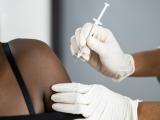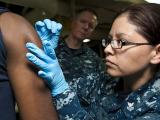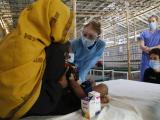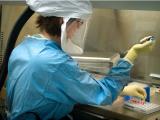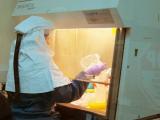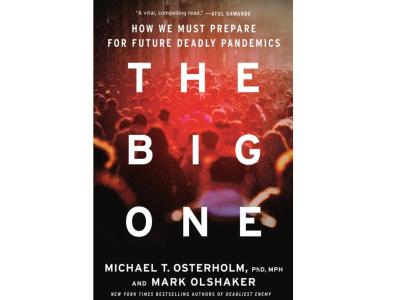May 1, 2002 (CIDRAP News) A lengthy report by an expert panel on anthrax generally echoes treatment and prevention recommendations made by federal health officials last fall while highlighting how little is known about the epidemiology of the disease, especially how many spores it takes to cause infection.
"It is still uncertain what the minimum dose of spores would be to cause infection in humans although it may theoretically be as few as 1 to 3 spores," states the report in the Journal of the American Medical Association by Thomas V. Inglesby, MD, of Johns Hopkins University in Baltimore, and 22 colleagues. The group reviewed recent literature to update the comprehensive report on anthrax as a biological weapon that they published in JAMA in 1999. The update was prompted by the anthrax attacks of last fall, which caused 22 confirmed or suspected cases. These included 11 cases of inhalational anthrax, 5 of them fatal, and 11 cutaneous cases (7 confirmed, 4 suspected).
During the response to the anthrax attacks, health officials said they believed it generally takes several thousand anthrax spores to cause inhalational anthrax. But the new report says that a recently published study involving monkeys suggests that the minimum infectious dose could be 1 to 3 spores. In addition, the two cases of fatal inhalational anthrax in New York City and Connecticut triggered speculation that the fatal dose for some people could be very low, the report notes.
On the other hand, before anthrax vaccination became a requirement for workers in US goat-hair mills in the 1960s, "many unvaccinated person-years of high-risk exposure had occurred, but only 13 cases of inhalational anthrax were reported," the article says. One study at a Pennsylvania mill showed that workers inhaled up to 510 Bacillus anthracis particles per 8-hour shift, but none of them got sick during the study period.
The risks posed by anthrax-tainted mail remain little understood, the report notes. The first anthrax cases last fall were linked to letters that had been opened, but later cases occurred in workers who handled unopened mail. "Much remains unknown about the risks to persons handling or processing unopened letters containing B anthracis spores," the authors say. "It is not well understood how the mechanical systems of mail processing in a specific building would affect the risk of disease acquisition in a worker handling a contaminated letter in that facility."
Another uncertainty is the risk that anthrax spores that have settled on surfaces can become airborne again. Before the Hart Senate Office Building was decontaminated in the wake of the anthrax-laced letter to Sen. Tom Daschle, the Environmental Protection Agency tested this risk by placing agar gel plates around the office and then simulating normal office activity, the panel reports. Sixteen of the 17 plates subsequently yielded B anthracis. This showed that routine activity in a contaminated area could cause "significant spore resuspension."
The report says that the five letters sent in last fall's attacks all were mailed from Trenton, N.J., and all contained the Ames strain of anthrax, but the source of the culture used to create the spores remains unknown. The letter sent to Daschle contained 2 g of powder, which was reported to contain 100 billion to 1 trillion spores per gram, though no official analysis of the powder has been published.
In light of the recent literature on anthrax, the report reviews epidemiology, microbiology, pathogenesis and clinical manifestations, diagnosis, vaccination, therapy, infection control, and decontamination. Some of the main points follow.
- The mortality rate in 20th century cases of inhalational anthrax in theUnited States was 89%, much higher than that in the 2001 attacks, in which 6 of 11 patients survived.
- The first 10 patients with inhalational anthrax in 2001 all presented with malaise and fever, and all had abnormal chest x-ray findings, in most cases including mediastinal widening, infiltrates, and pleural effusion.
- A standard blood culture is the most useful microbiologic test for inhalational anthrax; it should show growth of the organism in 6 to 24 hours. However, blood must be obtained before antibiotic treatment is started, because "blood cultures appear to be sterilized after even 1 or 2 doses of antibiotics."
- As recommended by the Centers for Disease Control and Prevention last fall, nasal swab tests should not be used as a clinical diagnostic test.
- The index case of inhalational anthrax in 2001 was identified "because of an alert clinician who suspected the disease on the basis of large gram-positive bacilli in cerebrospinal fluid in a patient with a compatible clinical illness" and because of the subsequent analysis by lab personnel who had had bioterrorism training.
- The optimal protection for potentially exposed people (postexposure prophylaxis) is vaccination plus a 60-day course of antibiotics. However, because the vaccine supply is currently limited, antibiotic treatment must be relied on for now.
- It is not yet clear whether the use of two or more antibiotics for inhalational anthrax is advantageous, but it is "a reasonable therapeutic approach" in view of the risks and the possibility that terrorists would use a resistant strain of anthrax. The preferred drugs are doxycycline and ciprofloxacin.
- Previous guidelines have recommended 7 to 10 days of antibiotic treatment for patients with skin anthrax, but people who get skin anthrax as a result of bioterrorism should get 60 days of antibiotic treatment because of the presumed accompanying risk of inhalational disease.
- Of the postal workers who were advised to take antibiotics after the anthrax attacks, 2% sought medical attention because of possible allergic reactions, but none had to be hospitalized because of reactions to the drugs.
- Rapid assay kits for detecting anthrax spores on environmental surfaces remain unproved, and they produced many false-positive results when used last fall. None of the tests have been evaluated or endorsed by federal health agencies.
Inglesby TV, O'Toole T, Henderson DA, et al. Anthrax as a biological weapon, 2002. JAMA 2002;287(17):2236-52
Full text
